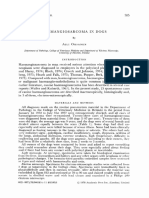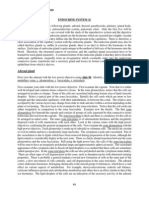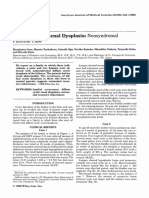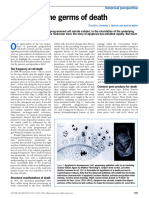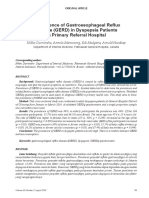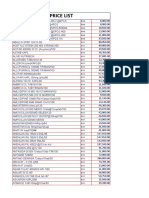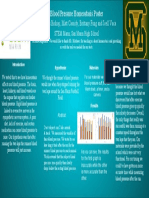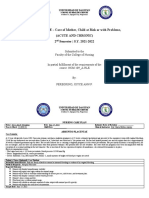Article
Article
Uploaded by
حمزہ محبCopyright:
Available Formats
Article
Article
Uploaded by
حمزہ محبOriginal Title
Copyright
Available Formats
Share this document
Did you find this document useful?
Is this content inappropriate?
Copyright:
Available Formats
Article
Article
Uploaded by
حمزہ محبCopyright:
Available Formats
A NOTE ON “MULBERRY CELLS” AND CLUSTERS
OF EOSINOPHILE SPHERULES, PROBABLY A
FORM OF RUSSELL’S “FUCHSINE BODIES” I N
THE WALLS OF A CHRONIC CEREBRAL ABSCESS
AND I N A CASE OF MULTIPLE MYELOMA.
M.D.
WEBER,M.D., F.E.C.P. and R. BLENDINGER,
By F. PAHKES
(PLATE111.)
THEsubject of the chronic cerebral abscess was a married woman, at. 37,
admitted into the German Hospital on 13th October 1904. She had suffered
from occasional headaches (since Christmas 1903) and vomiting ; but, though
she felt weak, had been up and about until three weeks before admission.
No history of fits or convulsions. Some years previously she had suffered
from spasmodic abdominal pains, possibly connected with cholelithiasis. In
regard to family history, it may be noted that her father lived to an old age
and her mother died of consumption. The patient had five children living
and healthy ; two others had died, of diphtheria and some uncertain cause,
respectively.
I n the hospital the patient was found to have advanced double optic
neuritis. The pupils were rather large, and reacted sluggishly to light.
Though there was no objective disturbance in the movements of the eyeballs,
diplopia of some kind was mentioned by the patient. There was no para-
plegia, but without assistance she could not remain in the standing position,
even with her eyes open, and she had a tendency to fall to the right. NO
disturbance of cutaneous sensation was detected, but there was apparently
slight inco-ordination in the upper extremities, shown by asking her to make
the tips of her two forefingers meet rather quickly in front of her. She
answered even the simplest questions slowly. We have no note as to the
condition of the knee-jerks and other reflexes. Xothing abnormal was
observed on physical examination of the thorax and abdomen. There was
no fever. The pulse varied between 76 and 88 per minute. The urine was
free from albumin and sugar. The patient died suddenly in the night on
28nd October. Treatment by iodide of potassium had been commenced on the
chance of the disease being due to syphilis.
At the necropsy on 22nd October nothing abnormal (spinal cord not
examined) was discovered on naked-eye examination, beyond the presence of
gall stones in the gall bladder and a chronic abscess (f softening gumnia) in
the brain. It is to this latter condition we have now to devote our attention.
The abscess was of about the size of a large walnut, measuring nearly 4 crns.
in the sagittal direction and about 2 4 crns. in the coronal and vertical direc-
tions, and was situated in the left cerebral hemisphere, just above the corpus
callosum and quite close to the intercerebral fissure, so as to cause bulging
when the hemispheres were separated. There was a thrombosed blood vessel
60 I;: PARKES WEBER AND R. BLENDINGER.
in the cerebral cortex in the neighbourhood of the abscess. I n this macro-
scopic exnmiuation of the brain we had the advantage of Dr. F. E. Batten’s
kind assistance. The other portions appeared not to be diseased, and this
would account for the absence of localising symptoms during life. The
abscess contained a thick, creamy, greenish, purulent-looking fluid, which
under the microscope was found to consist of granular material and cells, the
latter relatively few and in process of degeneration. The abscess wall was
firm and rather irregular, and this irregularity rather favoured the view that
the disease was of syphilitic origin. It may he stated at once that sections
were specially stained for tubercle bacilli with a negative result.
MICROSCOPICAL OF THE ABSCESS
EXAMINATION WALL.
Sections cut from paraffin blocks were stained in various ways. By the
mode of preparation all fat was of course necessarily got rid of. The tissue
was fibroid, with inflammatory cellular infiltration, merging on the outer side
into normal brain tissue. Besides lymphocytes there were a good many rather
large cells of an oval shape, which evidently, as the result of a degeneration
process, had an extremely small nucleus and a relatively large amount of
swollen-looking protoplasm, staining poorly with hmmatoxylin. It is, how-
eveq to a third kind of cells, representing, doubtless, a special form of
degeneration, to which we particularly wish to draw attention. These cells,
scattered here and there in the abscess wall, were of large size, with a single
relatively small nucleus, and contained spherical globules (Plate 111. Figs. 2
and 3) in their protoplasm, up to fifteen or twenty in number.
The spherules attracted attention owing to their retaining the
fuchsine colour in preparations which were stained with carbol-fuchsine
for tubercle bacilli, but they were likewise picked out by the eosine
in the ordinary haematoxylin-eosine staining, and could be well defined
by several other methods. On account of their peculiar appearance
we have called the cells containing the globules “ mulberry cells.” It
seems a~ if after a time the protoplasm becomes quite used up in the
formation and growth of these globules, so that the cells come to
consist of nothing but a small irregularly shaped nucleus and n mass
of spherules apparently held together by a kind of cement substance or
by a thin cell wall (Plate 111. Fig. 3). Then, as far as we can judge,
the nucleus disappears, and nothing but a cluster of spherules remains
(Plate 111. Fig. l), or the cell breaks and the sphernles are set free in the
tissue ; but even after this their arrangement in a group or cluster, and
the appearance of adherence of some of the spherules to each other,
often still suggest that they have been derived from the breaking up of
a single mulberry cell. I n the lowest of the three clusters represented
in Plate 111. Fig. 1, a emall body, stained deep blue, is to be noted
between the spherules, and appears to be the atrophied remnant of a
nucleus, as if the cluster in question had been derived from a,
mulberry cell similar to that represented in Fig. 3.
The diameter of the spherules in the mulberry cells and clusters is mostly
from one-sixth to rather more than the whole diameter of an ordinary red-
blood corpuscle. That is to say, that in diameter the spherules mostly vary
between 1.5 and 9 or 10p, but are sometimes decidedly larger, especially whelk
A NOTE O N “MULBERRY CELLS.” 61
only one or two are contained in a single cell. Some of the spherules at first
sight appearing to be free in the tissue are, on careful examination, found to
be single globules, replacing, practically, the whole of the cell protoplasm,
though a remnant of the nucleus is left. When many spherules are, as is
usually the case, contained in the same cell, they often vary considerably in
size. The spherules seem all ta be perfectly homogeneous, and we can make
out no vestige of structure in any of them. The larger ones stain, if any-
thing, more deeply with eosine than the smaller ones.
We may note incidentally that in some preparations the large
spherules apparently lying free in the tissue are a more striking
feature than in other preparations, and we have a suspicion that the
method of preparation may sometimes break up the cells, setting the
spherules free, or may cause smaller globules to coalesce to form
single large globules, either within cells or free in the tissue.
I n regard to the staining reactipns of the spherules, the following
are our results from the use of a variety of stains:-
1. Hsmatoxylin and eosine-the globules are stained red.
2. Methylene-blue and eosine-red.
3. Jenner’s methylene-blue and eosine combination ‘-faint red.
4. Mann’s long method of staining by his methyl-blue and eosine com-
bination 2-red.
5. Ehrlich’s triacid blood stain-crimson.
6. Methyl-violet-violet (i.c. not the pink staining of amyloid substance).
7. Carbol-fuchsine-red.
8. Puchsine and methylene-blue-purple.
9. Russell’s fuchsine and iodine-green method 3--red, often with a bluish
tinge ; sometimes, probably owing to faulty technique-blue.
It must be added that the spleen and a kidney from the eanie
case were examined microscopically. Nothing abnormal was seen in
the section of the kidney, but an interesting fact is that a few
clusters of spherules, similar to those found in the walls of the
cerebral abscess, were discovered in sections of the spleen. The
latter organ showed no amyloid change, but a hyaline-like degenera-
tion in the walls of some of the smaller blood vessels.
The mulberry cells and spherule clusters in the present case are
obviously very similar to those found in greater abundance in the
myelomatous bone marrow of a case described by one of us (F.P. W.)
and illustrated in the Medko-C‘hiruTgkal Tvamactwns, vol. lxxxvi?
Professor R. Muir of Glasgow, who kindly examined the tissue in that
case, reported :-
“ I n the protoplasm, moreover, there can be shown a larger number of
granules which vary considerably in size, but the smallest and most abundant
of which are distinctly larger than the neutrophile granules. With hrsmat-
1 Louis Jenuer, h a n u t , London, 1899, vol. i. p. 3iO.
G. Y a m , “Physiological Histology,” 1902, p. 216.
W. Russell, “An Address on a Characteristic Orgauism of Cancer,”Bd. Med. Jam.,
London, 1890, vol. ii. p. 1366.
F. Parkes Weber, ‘‘A Case of Multiple Myeloma,” bled.-Chir. Trans., London, 1903,
vol. lxxxvi. pp. 395 et q.
62 E PARKES WE3ER AND R. BLENDINGER.
oxylin and eosine these smallest granules are practically unstained By the
eosine ; with Ehrlich’s triacid they are coloured, but have not quita the same
tints as the neutrophiles, the staining being of a dirty brown colour; with
Mann’s eosine-methyl-blue combination they are stained bright red with a
slightly violet tint (whereas the neutrophiles are not stained) ; with Unna’s
polychrome methylene-blue the granularity is faintly visible, but the granules
are not really stained. ... I n addition, however, to these smnll granules,
many larger ones are present, and all intermediate sizes can be found up to
large rounded bodies as large as, or even larger than, ordinary red corpuscles.
I thought at first that these rounded bodies were included red corpuscles. . . .
Some of them also are seen lying free. They are more distinctly oxyphile
than the smaller granules, and stain with eosine by the ordinary methods. ...
They always seem to be perfectly spherical in form.” I n the account of the
case Dr. Weber added that some of the larger globules were two or three times
a8 large as ordinary red corpuscles. The globules of about the same size as red
corpuscles were, however, more numerous, and were moetly enclosed in cells
(Plate 111. Fig. 4) or arranged in clusters as if those of each cluster had been
formed in a single cell and were still held together in some way. Such
clusters often consisted of a dozen or more globules, and sometimes resembled
muZbt?rries (Plate 111. Fig. 6 ) or bunches of grapes.
Unfortunately, when we recently endeavoured to try fresh stains
on sections of a piece of the myelomatous bone marrow which had
been preserved in glycerin and formalin, we found that the tissue had
undergone some change, so that the globules could no longer be
properly stained. However, we believe it is clear that the globules,
whether enclosed in mulberry cells or lying free in the tissue, were
similar, if not quite identical, in their chemical nature in the two wees.
Mulberry-like cells, similar in form if not in their staining
reactions, have been described and figured by Gulland and Goodall in
their elaborate paper on pernicious ancmia. I n their cases of per-
nicious ansmia they found basophile cells with very large (‘dropsical-
looking granules ” in the intestinal submucosa. “ Every intermediate
stage,” they said, “ from the cell with ordinary granules t o those with
granules larger than erythrocytes, could be seen.”
Mr. S. G. Shattock kindly suggested to one of us that the spherules
in our cerebral abscess case might be allied to the so-called fuchsine
bodies originally described by W. Russell as cancer organisms. Buffer
and Walkers say :-
(‘By means of a special stain he (W. Russell) showed that these fuchsine
bodies occurred in little clusters of one UP to twenty or more. They formed
perfect spheres, nnd varied in size from 4 t o 12 p. They appeared to be
perfectly homogeneous and structureless, and the larger clumps were held
together by a delicate cementing substance, which stained faintly.”
So much does this description tally with what we have observed
in regard to the epherules and mulberry cells of our cerebral abscess
Path. and Bacterial, Edin. and London. 1905, vol. x. pp. 125 et seq.
1 Joum.
W. Russell, “ An Address on a Characteristic Organism of Cancer,” Brit. Meed. Jam.,
London, 1890, vol. ii. p. 1366.
a M. A. Ruffer aud J. H. Walker, “On some Parasitic Protozoa found in Cancerolls
Tumours,” Journ. Path. a d Baeteriol., Edin. and London, 1893, 701. i. p. ZOO.
A NOTE O N “MULBERRY CELLS.” 63
case, that we think the spheriiles in the latter case may certainly be
regarded as a form of Russell’s fuchsine bodies. We say advisedly
‘‘ a form of,” because it is possible that Russell’s “ fuchsine bodies ” are
not all exactly identical with each other.
It follows from all this that the spherules found in Weber’s
multiple myeloma case, to which we have already alluded, though
present in extraordinary abundance both in clumps within the cells
(sometimes in the form of mulberry cells) and scattered free in the
tissues, must likewise be regarded as probably forms of Russell’s
fuchsine bodies, in spite of the fact that they were never tested by
Russell’s fuchsine and iodine-green method of staining.
The importance of this conclusion lies partly, we believe, in the
fact that, since fuchsine bodies are now regarded by almost all
observers merely as products of cell degeneration,’ they are not likely
to possess any special pathological diagnostic significance in regard to
multiple myeloma, and it is unlikely that they are more closely con-
nected with multiple myeloma (and Bence-Jones’ albumosuria) than
with other conditions in which they have been found present. This
is confirmed by the fact that their presence has not been recorded in
most other published cases of multiple myeloma.
DESCRIPTION OF PLATE 111.
FIG. 1.-Part of the wall of the chronic cerebral abscess showing clusters of the spherules
stained red. Mann’s long method of staining by his eosine and methyl-blue
combination. (High magnification.)
FIG.?,.-From another section of the abscess wall. Two cells containing a great number
of relatively emall spherules stained purple by Russell’s fuchsine and iodine-
green method. (High magnification.)
FIG.3.-From another section of the abaceas wall. A mulberry cell in which the proto-
plasm has been apparently entirely rephced by the spherules. Eosine and
haematoxylin stain.
FIG.*.-From the multiple myeloma case. A granulated cell containing spherules of
various sizes stained red by Mann’s eosin and methyl-blue combination.
A somewhat diagrammatic representation, reproduced from the died.-Chir.
Tram., London, vol. lxxxvi.; but the blue colour of the nucleus in the
present illustration is more correct than that in the original figure.
FIG.5.-From the multiple myeloma case. A mulberry cell in which the protoplasm has
been apparently entirely replaced by spherdes of various sizes. The
nucleus is still visible. Mann’e eosine and methyl-blue stain with
haematoxglin. Figure reproduced lrom the Med.-Chir. Trans., London,
vol. Ixxxvi.
Vide Shattock and Ballance, Brit. dfrd. J o ~ n t . London,
, 1891, vol. i. p. 565, and
many later observers. Recent workers in Germany, we believo, regard Russell’s fuchsine
bodica as representing a form of hyaline degeneration.
JOURNAL OF PATHOLOGY.-VOL 11 PLATE 111
You might also like
- Lab Exercise 2Document4 pagesLab Exercise 2Angela Robles0% (1)
- Three Gliomata of Ependymal OriginDocument11 pagesThree Gliomata of Ependymal OriginGüray AktürkNo ratings yet
- 2 Large Concentrically Laminated Fibrinous Balls, Unattached, in The UrinaryDocument5 pages2 Large Concentrically Laminated Fibrinous Balls, Unattached, in The UrinarydranancyvetNo ratings yet
- Blood Elements in Certain Pisces With Special Reference To Galeichtys FelisDocument4 pagesBlood Elements in Certain Pisces With Special Reference To Galeichtys FelisKelly EmersonNo ratings yet
- Etiology of OtosclerosisDocument65 pagesEtiology of OtosclerosisANKIT PAREKHNo ratings yet
- ALZHEIMER'S DISEASE A REPORT OF SIX CASES Jnpsychiatry00011-0015Document30 pagesALZHEIMER'S DISEASE A REPORT OF SIX CASES Jnpsychiatry00011-0015geoaislaNo ratings yet
- Arias Stella Reaction 40Document16 pagesArias Stella Reaction 40Febry FirmansyahNo ratings yet
- 1880 - Laurie - The Embryology of A Scorpion (Euscorpius Italicus)Document43 pages1880 - Laurie - The Embryology of A Scorpion (Euscorpius Italicus)adriendrixNo ratings yet
- Congenital Hypertrophic Pyloric Stenosis With Report of Nine CasDocument40 pagesCongenital Hypertrophic Pyloric Stenosis With Report of Nine CasVașadi Razvan CristianNo ratings yet
- ArchamoebaeDocument8 pagesArchamoebaeJatziiNo ratings yet
- Protection Afforded by Sickle-Cell Trait Against Subtertian Malareal InfectionDocument5 pagesProtection Afforded by Sickle-Cell Trait Against Subtertian Malareal InfectionGary TanigawaNo ratings yet
- Sumber AnastesiDocument17 pagesSumber AnastesiKemala IntanNo ratings yet
- Group 3 Histopathology ReportDocument3 pagesGroup 3 Histopathology ReportCeline BerjotNo ratings yet
- Hypertrophic Pyloric Stenosis in The Adult: Johannesburg AetiologyDocument3 pagesHypertrophic Pyloric Stenosis in The Adult: Johannesburg AetiologyzapomannNo ratings yet
- A Pathological Study of Five Cases of Pyelonephritis in The NewbornDocument7 pagesA Pathological Study of Five Cases of Pyelonephritis in The NewbornNoor AlnajjarNo ratings yet
- Protozoologist London School of Tropical Medicine.Document7 pagesProtozoologist London School of Tropical Medicine.Franz Airy Figueroa VitalNo ratings yet
- 1-s2.0-S0143400406000348-mainDocument5 pages1-s2.0-S0143400406000348-mainedaNo ratings yet
- Test Bank For Robbins Basic Pathology, 9th Edition, Vinay Kumar, Abul Abbas, Jon Aster, All Chapter Instant DownloadDocument39 pagesTest Bank For Robbins Basic Pathology, 9th Edition, Vinay Kumar, Abul Abbas, Jon Aster, All Chapter Instant Downloadcaltoozhen100% (2)
- jbsms00046 0006Document2 pagesjbsms00046 0006nethhoNo ratings yet
- Dyscephalia Mandibulo-Oculo-FacialisDocument5 pagesDyscephalia Mandibulo-Oculo-FacialisReyes Ivan García CuevasNo ratings yet
- Chromosomes and Nucleoli of The Axolotl, Ambystoma MexicanumDocument40 pagesChromosomes and Nucleoli of The Axolotl, Ambystoma MexicanumBrayan Anaya LavalleNo ratings yet
- PMC2480949Document8 pagesPMC2480949Nat C.No ratings yet
- EclampsiaDocument7 pagesEclampsiaAbsalom MwazhaNo ratings yet
- Loshkajian 1997Document6 pagesLoshkajian 1997Ali AmokraneNo ratings yet
- Journal of Entomology and Zoology Volume Eleven, Number Two, June 1919From EverandJournal of Entomology and Zoology Volume Eleven, Number Two, June 1919No ratings yet
- HAEMANGIOSARCOMA in DOGSDocument11 pagesHAEMANGIOSARCOMA in DOGSPdea CanineNo ratings yet
- The Sickle Cell Membrane: Tip of The IcebergDocument38 pagesThe Sickle Cell Membrane: Tip of The IcebergClement BewajiNo ratings yet
- Lab 18 EndocrineDocument5 pagesLab 18 EndocrineRyan JamesNo ratings yet
- Ultrastructural Changes in Alveolar Epithelium in Response To Freund's Adjuvant (Faulkner & Esterly 1971)Document16 pagesUltrastructural Changes in Alveolar Epithelium in Response To Freund's Adjuvant (Faulkner & Esterly 1971)gd_hbarNo ratings yet
- 253 Nefra KystikiDocument3 pages253 Nefra KystikiPaul AsturbiarisNo ratings yet
- Small Mammal Hematology - Leukocyte Identification in Rabbits and Guinea PigsDocument7 pagesSmall Mammal Hematology - Leukocyte Identification in Rabbits and Guinea PigsRE Carranza GonzalesNo ratings yet
- Tuberculoma of The Brain: Department of Pathology, Andhra Medical College, VisakhapatnamDocument9 pagesTuberculoma of The Brain: Department of Pathology, Andhra Medical College, VisakhapatnamsanatthhNo ratings yet
- Jacob GenbioDocument11 pagesJacob Genbiojanjacob.fernandezNo ratings yet
- Congenital Cystic Disease of The Liver, Pancreas, and Kidney in A Nubian GoatDocument3 pagesCongenital Cystic Disease of The Liver, Pancreas, and Kidney in A Nubian GoatEma SomantriNo ratings yet
- 2Document10 pages2Marianne KatharinaNo ratings yet
- Hendler 1986Document8 pagesHendler 1986byhz7wwdm4No ratings yet
- Stippled Epiphyses in The Newborn and in Infants (Synonyms: Chondrodystrophia Calcificans Congenita, Dysplasia Epiphysialis Punctata)Document18 pagesStippled Epiphyses in The Newborn and in Infants (Synonyms: Chondrodystrophia Calcificans Congenita, Dysplasia Epiphysialis Punctata)Prateek Kumar PandaNo ratings yet
- 1koss - Diagnostic - Cytology Its Origins and PrinciplesDocument29 pages1koss - Diagnostic - Cytology Its Origins and PrinciplesyoussefandabenNo ratings yet
- Bio ReveiwerDocument12 pagesBio Reveiwerhvpalmes1822lagNo ratings yet
- Multiple Sclerosis Pathology Diagnosis and Management PDFDocument178 pagesMultiple Sclerosis Pathology Diagnosis and Management PDFHari25885No ratings yet
- Principles of DevelopmentDocument9 pagesPrinciples of Developmentsoccerrocksj18No ratings yet
- ApoptosiDocument3 pagesApoptosiMarcoZaccariNo ratings yet
- Notes On The Nephridia of Dinophilus and of The Larvae of Polygordius, Echiurus, and PhoronisDocument9 pagesNotes On The Nephridia of Dinophilus and of The Larvae of Polygordius, Echiurus, and Phoronisshubho_cool100% (2)
- Cells NotesDocument6 pagesCells NotesaabherideyNo ratings yet
- Lar Sell 1947Document51 pagesLar Sell 1947J.D. NobleNo ratings yet
- ALZHEIMER'S DISEASE WITH PREDOMINATING CROSSED CEREBRO Jnpsychiatry00007-0001Document10 pagesALZHEIMER'S DISEASE WITH PREDOMINATING CROSSED CEREBRO Jnpsychiatry00007-0001geoaislaNo ratings yet
- I. Embryology: Yolk.-The Yolk Comprises (1) The Cytoplasm of The Ordinary Animal Cell With Its Spongioplasm andDocument7 pagesI. Embryology: Yolk.-The Yolk Comprises (1) The Cytoplasm of The Ordinary Animal Cell With Its Spongioplasm andEzra GenerosoNo ratings yet
- I. Embryology: Yolk.-The Yolk Comprises (1) The Cytoplasm of The Ordinary Animal Cell With Its Spongioplasm andDocument7 pagesI. Embryology: Yolk.-The Yolk Comprises (1) The Cytoplasm of The Ordinary Animal Cell With Its Spongioplasm andEzra GenerosoNo ratings yet
- Kugelberg Welander SyndromeDocument4 pagesKugelberg Welander SyndromeAionesei VasileNo ratings yet
- An English I'ranslation of Alzheimer's 1907 Paper, "Über Eine Eigenartige Erlranliung Der Hirnrinde" 1995Document3 pagesAn English I'ranslation of Alzheimer's 1907 Paper, "Über Eine Eigenartige Erlranliung Der Hirnrinde" 1995drackfire_03No ratings yet
- Hematology of Infancy and ChildhoodDocument4 pagesHematology of Infancy and ChildhoodBiL aLNo ratings yet
- ModelDocument1 pageModelsunitha.murikiNo ratings yet
- edwards1958Document4 pagesedwards1958Thati PonceNo ratings yet
- Basal Cell Adenoma in A RabbitDocument1 pageBasal Cell Adenoma in A Rabbitandersonviana.medvetNo ratings yet
- Duchen 1980Document3 pagesDuchen 1980afifahridhahumairahhNo ratings yet
- Genbio SMILE LP1 Q1 WEEK1Document16 pagesGenbio SMILE LP1 Q1 WEEK1Ichinie KochinieNo ratings yet
- Cell Full PDFDocument23 pagesCell Full PDFhasandhali022No ratings yet
- Skeletal Lab Report PDFDocument7 pagesSkeletal Lab Report PDFapi-296594736No ratings yet
- Eye, Brain PDFDocument203 pagesEye, Brain PDFpopcruNo ratings yet
- 14 Tooth AbnormalitiesDocument152 pages14 Tooth Abnormalitiesحمزہ محبNo ratings yet
- 15-Traumatic Injuries of The TeethDocument79 pages15-Traumatic Injuries of The Teethحمزہ محبNo ratings yet
- Pasta: Process Mechanism and Its Production Technology: August 2006Document5 pagesPasta: Process Mechanism and Its Production Technology: August 2006حمزہ محبNo ratings yet
- Operative Past MCQsDocument10 pagesOperative Past MCQsحمزہ محبNo ratings yet
- 0e93ddaf12c8deee639c345ffb06d254Document46 pages0e93ddaf12c8deee639c345ffb06d254حمزہ محبNo ratings yet
- Fractures SolvedDocument9 pagesFractures Solvedحمزہ محبNo ratings yet
- Endo Operative SNDocument32 pagesEndo Operative SNحمزہ محبNo ratings yet
- Web Ad For Ariba - 16998Document1 pageWeb Ad For Ariba - 16998حمزہ محبNo ratings yet
- 3rd Prof Bds FormDocument3 pages3rd Prof Bds Formحمزہ محبNo ratings yet
- Press Ad (Wednesday) 28 12 2022Document2 pagesPress Ad (Wednesday) 28 12 2022حمزہ محبNo ratings yet
- Al Najm:38 39Document16 pagesAl Najm:38 39حمزہ محبNo ratings yet
- Log Sheet 2Document4 pagesLog Sheet 2SHAFIQNo ratings yet
- FUNDA Drug Computation AcenaDocument104 pagesFUNDA Drug Computation AcenaLawrence HanNo ratings yet
- Prevalence of Gastroesophageal Reflux Disease (GERD) in Dyspepsia Patients in Primary Referral HospitalDocument6 pagesPrevalence of Gastroesophageal Reflux Disease (GERD) in Dyspepsia Patients in Primary Referral HospitalAbrar TaraNo ratings yet
- Cimicifuga: Tubercular "I Feel So Alone, Forsaken and Depressed"Document4 pagesCimicifuga: Tubercular "I Feel So Alone, Forsaken and Depressed"nitkolNo ratings yet
- Chondroprotective Effects of The Combination ChondroitinDocument9 pagesChondroprotective Effects of The Combination Chondroitincursotplo2021No ratings yet
- Complications of Ischemic StrokeDocument40 pagesComplications of Ischemic StrokeVitas HaryantoNo ratings yet
- Daftar HargaDocument18 pagesDaftar HargaNoperitaNo ratings yet
- Shouldice Hospital CaseDocument4 pagesShouldice Hospital CaseRikiAchinta100% (1)
- Schizophrenia UndifferentiatedDocument64 pagesSchizophrenia UndifferentiatedJen GarzoNo ratings yet
- Yeasts Undergraduate Recording 2021Document33 pagesYeasts Undergraduate Recording 2021Dabrat JullzNo ratings yet
- Earthing EbookDocument70 pagesEarthing Ebookmikiheki100% (2)
- 130 CurriculumDocument60 pages130 CurriculumAndrian ChanNo ratings yet
- Kshar-Sutra Technique in The Cases of Fistula in AnoDocument17 pagesKshar-Sutra Technique in The Cases of Fistula in Anopranjan88No ratings yet
- 1 25Document4 pages1 25Najia ChoudhuryNo ratings yet
- Tatalaksana ARV - Efek Samping - IRIS - Monitoring Terapi - PEPDocument95 pagesTatalaksana ARV - Efek Samping - IRIS - Monitoring Terapi - PEPtriiNo ratings yet
- Novorapid® Flexpen®: What Is in This Leaflet What Novorapid® Is Used ForDocument9 pagesNovorapid® Flexpen®: What Is in This Leaflet What Novorapid® Is Used ForjessyNo ratings yet
- Blood Pressure Homeostasis PosterDocument1 pageBlood Pressure Homeostasis Posterapi-352673659No ratings yet
- Which Is More Accurate in Measuring The Blood Pressure? A Digital or An Aneroid SphygmomanometerDocument4 pagesWhich Is More Accurate in Measuring The Blood Pressure? A Digital or An Aneroid SphygmomanometerSri YatiNo ratings yet
- Management of Discolored ToothDocument19 pagesManagement of Discolored ToothTsega SK0% (1)
- NCP-ABRUPTIO PLACENTAE - PeregrinoDocument5 pagesNCP-ABRUPTIO PLACENTAE - PeregrinoJOYCE ANN PEREGRINONo ratings yet
- Ethical & Legal IssuesDocument6 pagesEthical & Legal IssuesMarion SanchezNo ratings yet
- Eclipsemed Ed TAG0508v2-050808Document1 pageEclipsemed Ed TAG0508v2-050808api-19522927No ratings yet
- Infection Control Progress Report Trust BoardDocument30 pagesInfection Control Progress Report Trust BoardJohn McCooeNo ratings yet
- Positive Psychotherapy AssignmentsDocument9 pagesPositive Psychotherapy AssignmentsAyushi GargNo ratings yet
- AnaphylaxisDocument10 pagesAnaphylaxisMadyline VictoryaNo ratings yet
- Tms 6Document11 pagesTms 6Ghea SugihartiNo ratings yet
- SRH Case Study-GadDocument7 pagesSRH Case Study-Gadapi-721737872No ratings yet
- Materi 5 - DR. Dr. Naomi Esthernita Preterm Infant FeedingDocument39 pagesMateri 5 - DR. Dr. Naomi Esthernita Preterm Infant FeedingandinaNo ratings yet
- EPISTAXIS-bleeding From The Nose (Most Common) Etiology (Cause)Document34 pagesEPISTAXIS-bleeding From The Nose (Most Common) Etiology (Cause)Julliza Joy PandiNo ratings yet


























